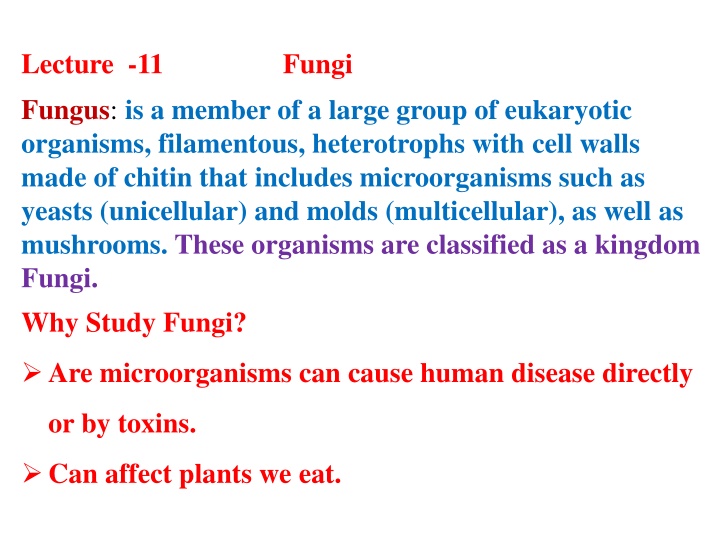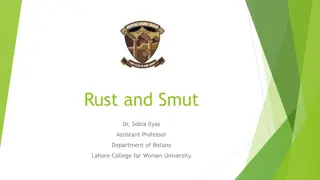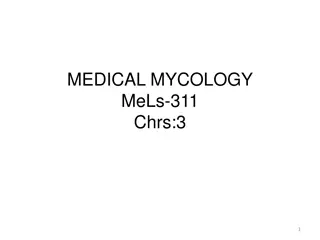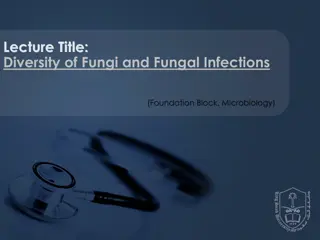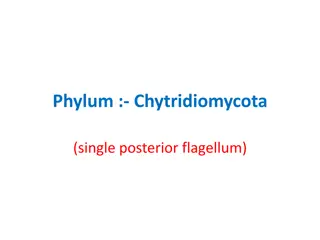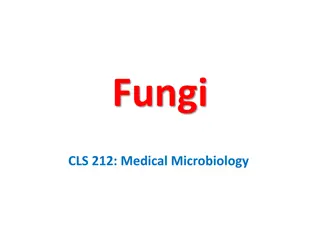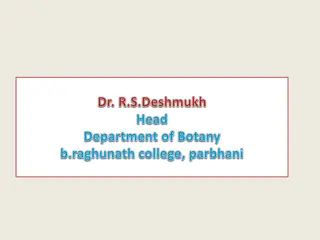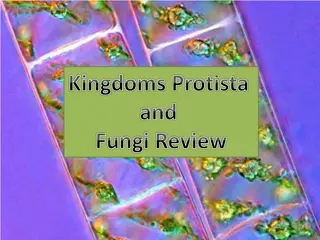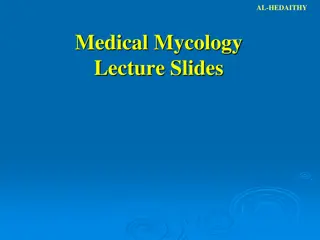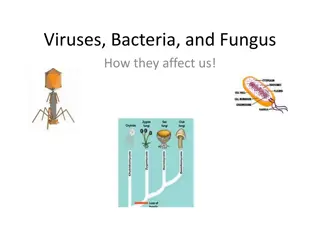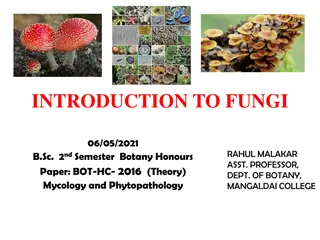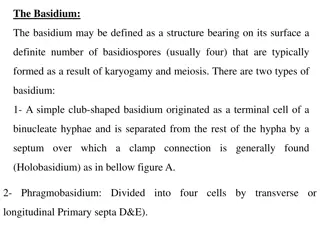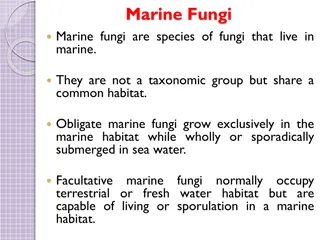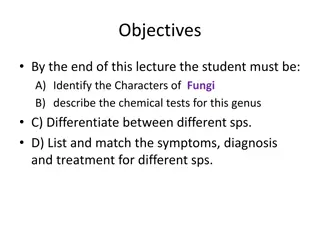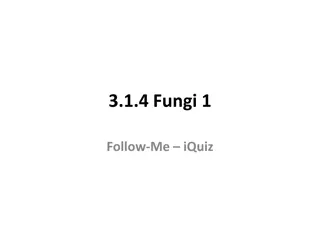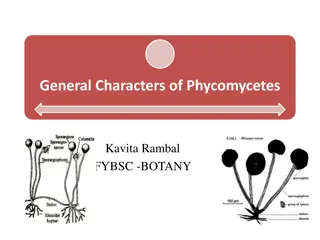Fungi: Key Characteristics and Functions
Fungi are eukaryotic organisms with unique modes of nutrition, playing vital roles in ecosystems. They feed by absorbing nutrients from their surroundings and can impact human health and agriculture. Learn about the structure, reproduction, and classifications of fungi in this informative overview.
Download Presentation

Please find below an Image/Link to download the presentation.
The content on the website is provided AS IS for your information and personal use only. It may not be sold, licensed, or shared on other websites without obtaining consent from the author.If you encounter any issues during the download, it is possible that the publisher has removed the file from their server.
You are allowed to download the files provided on this website for personal or commercial use, subject to the condition that they are used lawfully. All files are the property of their respective owners.
The content on the website is provided AS IS for your information and personal use only. It may not be sold, licensed, or shared on other websites without obtaining consent from the author.
E N D
Presentation Transcript
Lecture -11 Fungi Fungus: is a member of a large group of eukaryotic organisms, filamentous, heterotrophs with cell walls made of chitin that includes microorganisms such as yeasts (unicellular) and molds (multicellular), as well as mushrooms. These organisms are classified as a kingdom Fungi. Why Study Fungi? Are microorganisms can cause human disease directly or by toxins. Can affect plants we eat.
Modes of nutrition All fungi are heterotrophs; are not able to ingest their food like animals do, nor can they manufacture their own food the way plants do. Instead, fungi feed by absorption of nutrients from the environment around them. They accomplish this by growing through and within the substrate on which they are feeding. Most fungi are saprophytes, feeding on dead or decaying material. Fungi=absorptive heterotrophs Heterotroph (chemo-organotrophs): an organism incapable of synthesizing carbohydrates from inorganic sources; requires preformed organic carbon source for growth. **The body of a fungus (thallus ) consists largely of filamentous chains of cells called hyphae , some hyphae have septa (septate), some don t (aseptate ). ( ) . ) ) ( (
The hyphae secrete digestive enzymes which break down the substrate, making it easier for the fungus to absorb the nutrients which the substrate contains. Therefore, the natural habitat of almost all fungi is soil or water containing decaying organic matter. General Properties of Fungi: 1- Fungus is a member of eukaryotic organisms which includes yeasts and Molds. 2- Fungi feed by absorption of nutrients from environment. Hyphae secrets digestive enzymes which breaks down the substrate and makes it easier for fungus to absorb the nutrients 3- Fungi vary widely in size & shape from unicellular microscopic organism to multicellular organism. 4- Spore size, shape & structure are used in the classification & identification of fungi. .
5- hyphae and other structures form mycelium. 6- Fungi reproduces sexually and asexually. 7- Fungi are classified based upon hyphae , spore and reproduction. 8- Fungal infections are localized skin infections and systemic infections. 9- Mycoses are diseases caused by fungi. 10- Many are ecologically important saprophytes (consume dead and decaying matter). . 8 - . . .) Basic Structures Hypha: fundamental tube-like structural units of fungi a- Septate: divided by cross walls. b- Aseptate: lacking cross walls. : - : . 6 - . 5 - 7 - . - 9 - 10 ( Hypha : - .
Mycelium : a mass of hyphae forming the vegative portion of the Fungus a - Aerial - growing or existing in the air b - Vegetative - absorbs nutrients c - Fertile - bears conidia or spores for reproduction. - - . Spores Sporulation & Spores - Fusion of nuclear material. - : - - -
Fungi Reproduction 1 - Sexual Reproduction 2 -Asexual Reproduction It occurs by the following methods. 1 - Fragmentation In this process, the mycelium breaks into two or more similar fragments. Each fragment grows into a new mycelium. 2 - Budding The parent cell produces one or more projections called buds, which later develop necessary structures and detach to grow into new individuals. Budding is common in unicellular forms like yeast. 3 - Fission In this process, the parent cell splits into two equal halves, each of which develop into a new individual. Fission is also common in yeast.
SPORES Asexual spores -Arthrospore -Blastospore -Chlamydospore -Conidia * Microconidia * Macroconidia Sexual spores -sexual reproduction is NOT common in fungi. Ascospore Basidiospore Zygospore
Fungi form two key mutualistic symbiotic associations: : 1- Lichens: A lichen is a mutualistic symbiotic association between a fungus and a photosynthetic algae or cyanobacterium. 2- Mycorrhizae: Mycorrhizae are mutualistic symbiotic associations between fungi and the roots of plants. Classification of fungi - Depending on Morphology 1 - Yeasts - Unicellular fungi, nonfilamentous, typically oval or spherical cells. Reproduce by mitosis: - Yeasts are facultative anaerobes, which allows them to grow in a variety of environments. When oxygen is available, they carry out aerobic respiration, when oxygen is not available, they ferment carbohydrates to produce ethanol and carbon dioxide.
2 - Molds The molds form large multicellular aggregates of long branching filaments, called hyphae. There are vegetative hyphae and reproductive hyphae. Spores are borne on the reproductive hyphae. Spore size, shape and structure are used in the classification and identification of fungi.
3 - Yeast like fungi Grow partly as yeasts and partly as elongated cells resembling hyphae which are called pseudo hyphae . e.g. Candida albicans 4 - Dimorphic fungi Most fungi causing systemic infections are dimorphic: Dimorphism in pathogenic fungi typically depends on temperature: At 37oC: Yeast form. At 25oC: Mold form.
Dimorphism in nonpathogenic fungi may depend on other factors: Carbon dioxide concentration.
